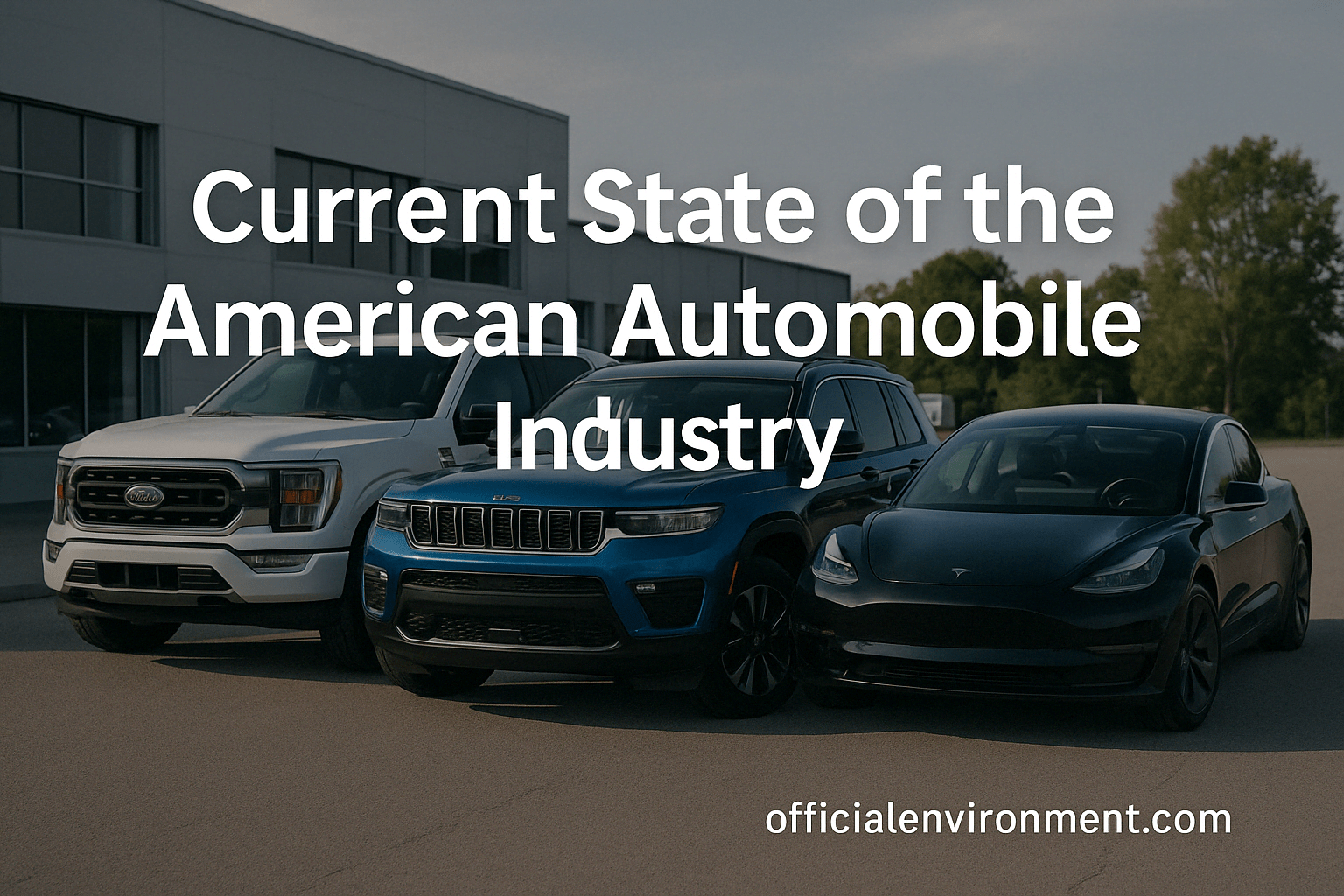The history of the American automobile industry is a fascinating journey marked by innovation, economic influence, and cultural significance. From the pioneering days of Henry Ford's assembly line to the contemporary electric vehicle revolution, this industry has undergone remarkable transformations that have shaped the nation's economy, culture, and lifestyle. In this comprehensive analysis, we'll delve deeper into the historical evolution, current state, and future trends of the American automobile industry, exploring its multifaceted impact on various aspects of society and the economy.
Historical Overview
Early Days and the Rise of Mass Production
The roots of the American automobile industry can be traced back to the late 19th century when visionaries like Henry Ford, Ransom Olds, and Charles and Frank Duryea began experimenting with motorized vehicles. However, it was Henry Ford's groundbreaking introduction of the assembly line in 1913 that revolutionized the industry. The assembly line drastically reduced production costs, making cars more affordable for the average American.
By the 1920s, the automobile had become a symbol of the American Dream, representing freedom, mobility, and economic prosperity. The industry experienced a significant boom, with numerous manufacturers entering the market, including General Motors, Ford, and Chrysler. The Great Depression of the 1930s posed challenges, but the industry adapted, introducing innovative marketing strategies and streamlined designs.
Post-War Boom and Global Competition
After World War II, the American automobile industry experienced an unprecedented boom. The country's economy was thriving, and consumers were eager to embrace the latest automotive innovations. Detroit, often referred to as the "Motor City," became the epicenter of the industry, with the "Big Three" (General Motors, Ford, and Chrysler) dominating the market.
However, the latter half of the 20th century brought new challenges. Increasing competition from foreign automakers, particularly Japanese and European companies, challenged the dominance of American manufacturers. The 1970s oil crisis further strained the industry, leading to a shift towards smaller, more fuel-efficient vehicles.
Current State of the American Automobile Industry
As of the early 2020s, the American automobile industry continues to be a major player on the global stage. One notable trend is the dominance of SUVs (Sport Utility Vehicles) and trucks in the market. These larger vehicles have gained popularity due to their versatility, perceived safety, and the demand for more spacious and comfortable rides.
Brands like Ford, Chevrolet, and Jeep have capitalized on this trend, offering a wide range of SUVs and trucks to cater to diverse consumer preferences. This shift towards larger vehicles has not only impacted consumer choices but has also influenced the industry's manufacturing and marketing strategies.
The SUV and truck market in the United States has experienced significant growth, with consumers drawn to the perceived safety advantages, ample cargo space, and a commanding driving position offered by these vehicles. Manufacturers have responded by introducing a plethora of SUV and truck models with varying features and capabilities, creating a competitive landscape that caters to a broad spectrum of consumer needs and preferences.
Electric Vehicles (EVs) and Sustainable Practices
Another significant development in the American automobile industry is the increasing focus on electric vehicles (EVs) and sustainable practices. With growing environmental concerns and advancements in battery technology, several automakers are investing heavily in electric and hybrid models.
Companies like Tesla, with its charismatic CEO Elon Musk, have been at the forefront of this electric vehicle revolution. The introduction of tax incentives for electric vehicle buyers and the commitment of major automakers to reduce carbon emissions have further accelerated the adoption of EVs in America.
The push towards electric vehicles is not only driven by environmental considerations but also by changing consumer preferences and regulatory pressures. Automakers are actively developing and promoting electric models to align with stricter emission standards and to meet the increasing demand for eco-friendly transportation options.

Technological Integration and Connectivity
In recent years, the American automobile industry has witnessed a rapid integration of advanced technologies and connectivity features. Smart cars with in-car entertainment systems, autonomous driving capabilities, and advanced safety features have become commonplace. Major automakers are investing in research and development to stay competitive in this tech-driven landscape.
The rise of electric and autonomous vehicles has also given birth to new players in the industry, such as tech giants Google and Apple, further intensifying competition and pushing traditional automakers to innovate. The integration of technology extends beyond the vehicle's performance, with a focus on enhancing the overall driving experience through features like advanced infotainment systems, navigation assistance, and connectivity with smartphones and other devices.
Impact on Society and Economy
The automobile industry has long been a significant contributor to the American economy. According to the Alliance for Automotive Innovation, the automotive sector accounts for approximately 3% of the United States' gross domestic product (GDP). This includes manufacturing, dealerships, aftermarket services, and related industries.
The industry's economic impact extends beyond its direct contributions, influencing sectors like steel, rubber, glass, and electronics. As one of the largest employers in the country, the automobile industry provides jobs for millions of Americans, both directly and indirectly.
The economic ripple effect of the automobile industry is vast, encompassing a network of suppliers, service providers, and dealerships that contribute to the overall economic health of communities across the nation. The interconnected nature of the automotive ecosystem means that fluctuations in the industry can have far-reaching effects on employment rates, consumer spending, and the broader economic landscape.
The automobile is deeply embedded in American culture, symbolizing freedom, individualism, and the open road. Car ownership has long been associated with personal identity and social status. The iconic American road trip, immortalized in literature and film, is a testament to the cultural significance of automobiles in the nation.
Muscle cars from the 1960s, such as the Ford Mustang and Chevrolet Camaro, hold a special place in American popular culture. These vehicles are not just modes of transportation; they are symbols of innovation, style, and a bygone era of automotive enthusiasm.
Beyond the realm of popular culture, automobiles have played a crucial role in shaping urban planning influencing the design of cities and suburbs. The advent of the interstate highway system in the mid-20th century transformed travel patterns, making long-distance journeys more accessible and reshaping the geography of American communities.

Environmental Impact and Sustainability
While the automobile industry has contributed significantly to economic growth and cultural identity, it has also faced criticism for its environmental impact. The combustion of fossil fuels in traditional vehicles contributes to air pollution and greenhouse gas emissions, contributing to climate change.
In response to these concerns, the industry has been actively pursuing sustainable practices. The push towards electric vehicles, advancements in fuel efficiency, and commitments to reduce carbon footprints are steps towards creating a more environmentally friendly automobile industry.
The adoption of sustainable practices goes beyond the vehicles themselves. Manufacturers are increasingly focusing on sustainable sourcing of materials, reducing energy consumption in production processes, and implementing eco-friendly waste management strategies. These initiatives aim to minimize the overall ecological footprint of the automotive industry and contribute to a more sustainable and responsible approach to manufacturing.
Future Trends and Challenges
Electric and Autonomous Vehicles
The future of the American automobile industry is undoubtedly intertwined with electric and autonomous vehicles. Many major automakers have announced ambitious plans to transition their fleets towards electrification, with some pledging to go fully electric within the next decade.
The development of autonomous driving technology is another area of intense focus. Companies like Tesla, Google's Waymo, and traditional automakers are investing heavily in creating self-driving vehicles. The potential benefits of autonomous vehicles, such as reduced accidents and increased mobility for the elderly and disabled, are driving this technological race.
Sustainable Manufacturing Practices
As environmental concerns continue to grow, there is a heightened focus on sustainable manufacturing practices within the automobile industry. This includes the use of eco-friendly materials, energy-efficient production processes, and responsible waste management.
Some automakers are embracing circular economy principles, striving to design vehicles that are easier to recycle and minimizing the environmental impact of manufacturing. This shift towards sustainability not only aligns with consumer expectations but also helps the industry contribute positively to environmental conservation.
While the future looks promising for the American automobile industry, it is not without challenges and uncertainties. The transition to electric vehicles poses infrastructure challenges, including the need for an extensive charging network. Consumer acceptance and affordability of electric cars are also crucial factors that will determine the success of this transition.
The development of autonomous vehicles faces regulatory hurdles and concerns related to safety and cybersecurity. The industry must navigate these challenges while ensuring that ethical considerations and potential societal impacts are taken into account.





